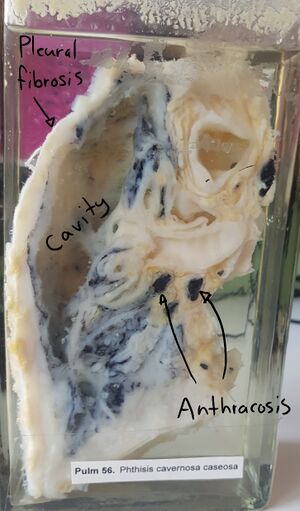34. Phthisis cavernosa
Organ: Lung
Description:
The pleura is thickened and whitish. There is a large cavity in place of the parenchyme. There is also anthracosis of the lymph nodes.
Diagnosis: Phthisis cavernosa/pulmonis
Causes:
- Post-primary tuberculosis
- Exogenous re-infection after a primary tuberculosis
Theory:
Some years after a primary tuberculosis infection can the patient get re-infected by m. tuberculosis from the outside. This activates another “case” of tuberculosis in the patient, called post-primary tuberculosis by exogenous re-infection.
The re-infection will affect the lungs. It will necrotize the parenchyme, starting at the apex, producing a type of cavity called a secondary cavity. The necrosis is of caseating type. After the apex parenchyme has been destroyed will the infection gradually descend toward the base of the lung, destroying the parenchyme on its way. This descending process is called Assman infiltration. The result of this parenchymal destroying is the formation of cavities, forming the phthisis cavernosa we see here.
The thickening of the pleura is due to pleural fibrosis. Pleural fibrosis is part of the healing process of tuberculosis. The anthracosis is unrelated to the tuberculosis.

